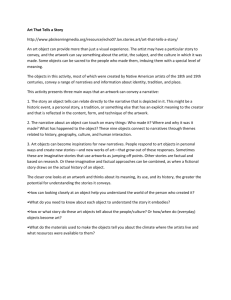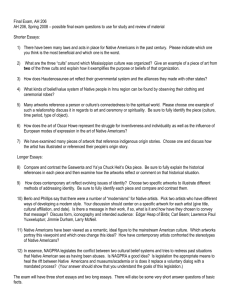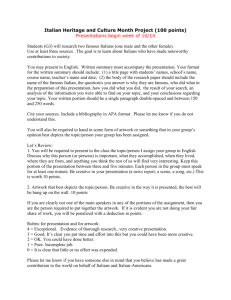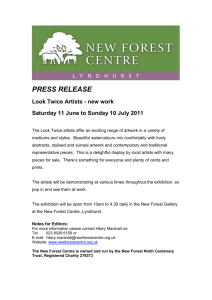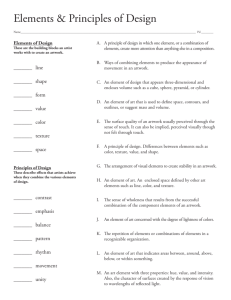moving through time with art movements - Brain
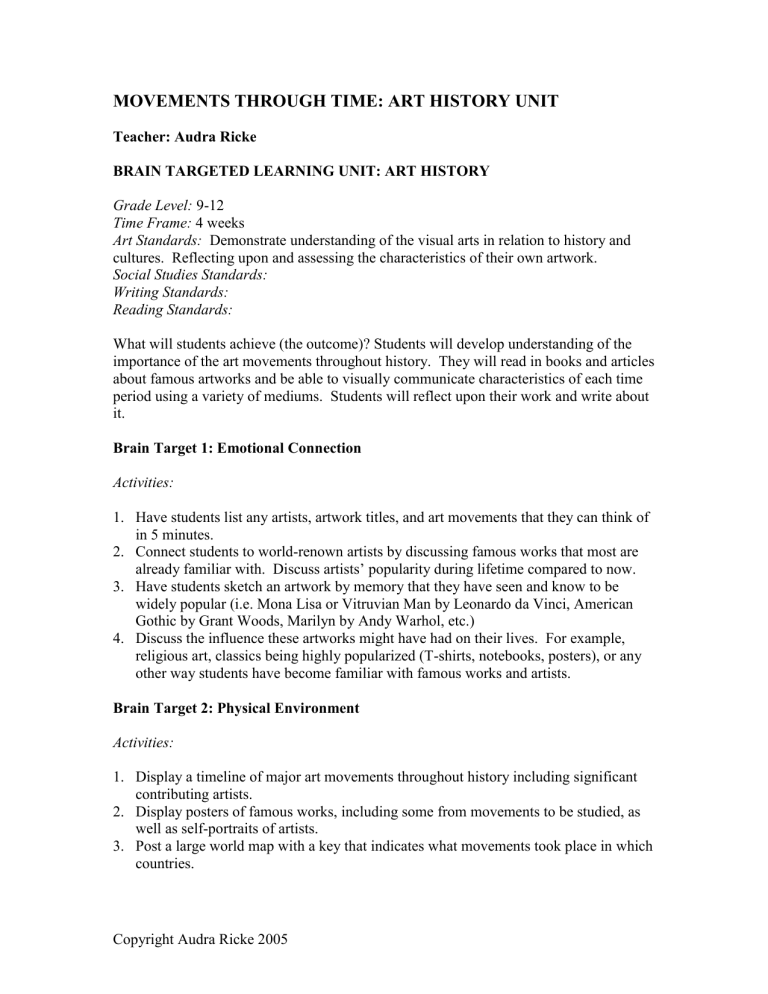
MOVEMENTS THROUGH TIME: ART HISTORY UNIT
Teacher: Audra Ricke
BRAIN TARGETED LEARNING UNIT: ART HISTORY
Grade Level: 9-12
Time Frame: 4 weeks
Art Standards: Demonstrate understanding of the visual arts in relation to history and cultures. Reflecting upon and assessing the characteristics of their own artwork.
Social Studies Standards:
Writing Standards:
Reading Standards:
What will students achieve (the outcome)? Students will develop understanding of the importance of the art movements throughout history. They will read in books and articles about famous artworks and be able to visually communicate characteristics of each time period using a variety of mediums. Students will reflect upon their work and write about it.
Brain Target 1: Emotional Connection
Activities:
1. Have students list any artists, artwork titles, and art movements that they can think of in 5 minutes.
2. Connect students to world-renown artists by discussing famous works that most are already familiar with. Discuss artists’ popularity during lifetime compared to now.
3. Have students sketch an artwork by memory that they have seen and know to be widely popular (i.e. Mona Lisa or Vitruvian Man by Leonardo da Vinci, American
Gothic by Grant Woods, Marilyn by Andy Warhol, etc.)
4. Discuss the influence these artworks might have had on their lives. For example, religious art, classics being highly popularized (T-shirts, notebooks, posters), or any other way students have become familiar with famous works and artists.
Brain Target 2: Physical Environment
Activities:
1. Display a timeline of major art movements throughout history including significant contributing artists.
2. Display posters of famous works, including some from movements to be studied, as well as self-portraits of artists.
3. Post a large world map with a key that indicates what movements took place in which countries.
Copyright Audra Ricke 2005
4. Students will create one artwork for each movement. Display students’ artwork or any visual aids as they progress through the unit.
5. Plan cooperative groups of 4 students and arrange tables or desks to accommodate.
6. Designate a bookshelf to contain art history books and magazines containing colored plates and artist biographies.
7. While students are working, play music typical of the time period being studied.
Brain Target 3: Big-Picture Activity
Learning Goals: Students will know the major art movements throughout history.
Students will know characteristics of each movement, prominent artists and works, as well as the country(ies) the movement took place in. Given an artwork, students will be able to identify the movement/time period it is from.
Activities:
1.
Students will complete a KWL chart indicating what they know about art history
2. Students will complete blank map and label art movements and their respective countries.
Brain Target 4: Declarative & Procedural Knowledge
Learning Goals: Students will know the art movements, be able to identify their characteristics, and be able to visually communicate their characteristics.
Activities:
1. In groups, students will view overhead PowerPoint projections of artworks and identify the time period/movement that it is from.
2. Students will match artist to work title on worksheet while view the artworks on an overhead PowerPoint.
3. Individually students will create one piece of art for each art movement using drawing, painting, collage, digital photography/computer, printmaking, etc. For each work, at least one paragraph will be written explaining why their piece fits into the specific movement.
Brain Target 5: Teaching for Extension and Application of Knowledge
Learning Goal: Students will research and present the artists, time frame, artwork, and other details pertaining to one specific art movement in history.
Activity: In groups, students will choose one art movement to focus on (no two groups will be allowed the same topic). They will research characteristics of the artwork, artists who were pioneers in this area, the years it took place, and where it took place. Each student will individually write a one page essay about the influence of their art movement.
Copyright Audra Ricke 2005
Real-World Activity: Using their research, students will compile a brochure and a large poster that will be displayed in the classroom to create a “museum” of art history. Each display should contain at least one example artwork from the time period and one original artwork created by the students that uses characteristics of the movement.
Learning Goal: Students will be familiarized with a majority of the art movements throughout history.
Activity: Students will give a 5-10 minute presentation about their display to the class and pass out brochures on their art movement.
Brain Target 6: Evaluating Learning
1. Use a rubric to evaluate presentations.
2. Have students self-evaluate their group’s display, brochure, and presentation.
2. Use a rubric to evaluate each student’s essay.
3. Check accuracy of PowerPoint activity.
4. Use a rubric to evaluate original artwork students create and corresponding written response.
5. Check accuracy of map labeling activity.
Copyright Audra Ricke 2005


